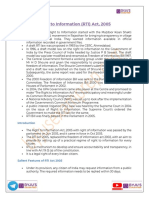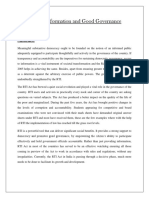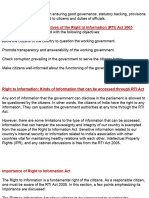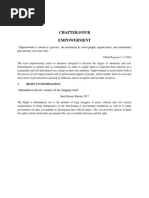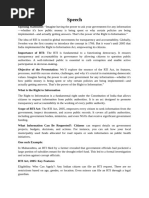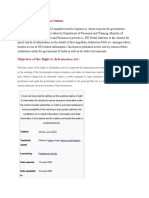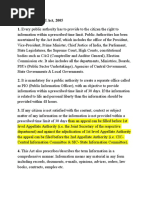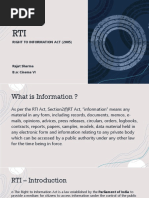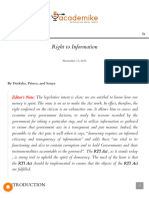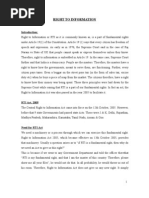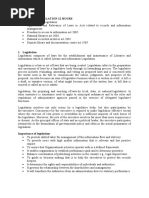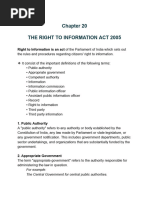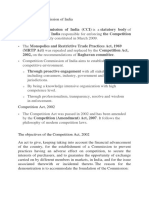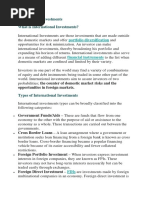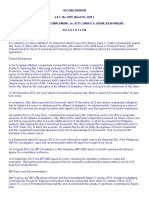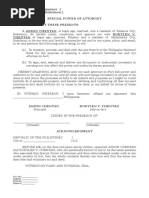0 ratings0% found this document useful (0 votes)
75 viewsRTI Act
RTI Act
Uploaded by
Mehak joshiThe Right to Information Act (RTI Act) gives Indian citizens the right to request information from public authorities. It aims to promote transparency and accountability in government institutions. Under the RTI Act, citizens can request information about an organization's structure, functions, and finances. The RTI Act defines public authorities broadly to include government ministries, public sector companies, and non-government organizations receiving government funds. It establishes a process for citizens to file information requests and puts time limits on responses. However, tensions sometimes arise between the right to information and the right to privacy. Recent amendments to the RTI Act have reduced the independence of information commissions.
Copyright:
© All Rights Reserved
Available Formats
Download as PDF, TXT or read online from Scribd
RTI Act
RTI Act
Uploaded by
Mehak joshi0 ratings0% found this document useful (0 votes)
75 views5 pagesThe Right to Information Act (RTI Act) gives Indian citizens the right to request information from public authorities. It aims to promote transparency and accountability in government institutions. Under the RTI Act, citizens can request information about an organization's structure, functions, and finances. The RTI Act defines public authorities broadly to include government ministries, public sector companies, and non-government organizations receiving government funds. It establishes a process for citizens to file information requests and puts time limits on responses. However, tensions sometimes arise between the right to information and the right to privacy. Recent amendments to the RTI Act have reduced the independence of information commissions.
Copyright
© © All Rights Reserved
Available Formats
PDF, TXT or read online from Scribd
Share this document
Did you find this document useful?
Is this content inappropriate?
The Right to Information Act (RTI Act) gives Indian citizens the right to request information from public authorities. It aims to promote transparency and accountability in government institutions. Under the RTI Act, citizens can request information about an organization's structure, functions, and finances. The RTI Act defines public authorities broadly to include government ministries, public sector companies, and non-government organizations receiving government funds. It establishes a process for citizens to file information requests and puts time limits on responses. However, tensions sometimes arise between the right to information and the right to privacy. Recent amendments to the RTI Act have reduced the independence of information commissions.
Copyright:
© All Rights Reserved
Available Formats
Download as PDF, TXT or read online from Scribd
Download as pdf or txt
0 ratings0% found this document useful (0 votes)
75 views5 pagesRTI Act
RTI Act
Uploaded by
Mehak joshiThe Right to Information Act (RTI Act) gives Indian citizens the right to request information from public authorities. It aims to promote transparency and accountability in government institutions. Under the RTI Act, citizens can request information about an organization's structure, functions, and finances. The RTI Act defines public authorities broadly to include government ministries, public sector companies, and non-government organizations receiving government funds. It establishes a process for citizens to file information requests and puts time limits on responses. However, tensions sometimes arise between the right to information and the right to privacy. Recent amendments to the RTI Act have reduced the independence of information commissions.
Copyright:
© All Rights Reserved
Available Formats
Download as PDF, TXT or read online from Scribd
Download as pdf or txt
You are on page 1of 5
RTI Act, 2005 -
The Right to Information Act is considered to be one of
the most successful laws in India. It is the law that gives an
ordinary citizen the right to ask questions to the government.
This includes:
• Disclosure of their organisation, function and structure.
• Powers and duties of its officers and employees
• Financial information.
The Public Authority here includes the bodies of self-
government established under the constitution or any law
or government notification. These include the Ministries,
public sector undertakings and regulators.
It also includes any entities owned, controlled or substantially
financed and non-governmental organisations substantially
financed directly or indirectly by funds provided by the
government.
What is the need of RTI ?
• Right to information is the need of the current
scenario because it assists to maintain transparency and
accountability in government work.
• This Act is very necessary for each and everyone due to
this our government officials and public
institutions gathered information and worked upon
them.
• It embedded the right of every citizen of India to have
access or control of the information related to finance
to any authority by the state, thereby responsibility arises
on the authority to use the information effectively
without including any corrupt activities.
• The poor and underprivileged are also empowered by
this Act, which grants them the right to seek and receive
information on government policies and actions. This, in
turn, results in their well-being.
• It has exposed high-level corruption, such as in the
Commonwealth Games organisation and the distribution
of 2G spectrum and coal blocks.
• It increases policymakers' decision-making capabilities
by removing unneeded secrecy.
What is the process of filing a complaint under RTI ?
The Act also said that any person may file a written request
to an officer (PIO) which is appointed by the authority which
is covered by this Act.
It is the obligation to entertain the request made by
citizens. If the officer is not present then the applicant has the
option to file a request in front of the state or “central
information commission”.
It also provides a time limit so that the process can be done
speedily. Different time limits are prescribed for different
situations:
• When an application is entertained by any PIO then they
have an obligation to reply to the application within a
time limit of 30 days and any application which is
presented before assistant PIO must be replied to
within 35 days.
• The application transfers to another PIO in 30
days which starts or counts from the day on which its
application is transferred.
• Any application presented in relation to information
regarding corruption by any schedule secured agency or
any kind of violation of human rights which are covered
under schedule II of RTI Act then reply must be
given within 45 days with the permission of the central
information commission.
• PIO is required to give information which
includes “right to life and liberty” of the person.
What is the Role Of The Government In RTI ?
• Section 26 of the Act enjoins the central government, as
also the state governments of the Union of India
(excluding J&K), to initiate necessary steps to:
• Develop educational programs for the public especially
disadvantaged communities on RTI.
• Encourage Public Authorities to participate in the
development and organization of such programs.
• Promote timely dissemination of accurate information
to the public.
• Train ocers and develop training materials.
• Compile and disseminate a User Guide for the public in
the respective local language.
• Publish names, designation postal addresses and contact
details of PIOs and other information such as notices
regarding fees to be paid, remedies available in law if the
request is rejected etc.
RTI vs Right to Privacy
• As Right to Information and Right to Privacy are
premised upon radically different normative foundations,
and they offer divergent theorems henceforth, it is
inevitable to come across clashes in between.
• Considering one man’s freedom of information is
another man’s invasion of privacy; a right to receive
information to achieve greater transparency in public life
could impinge on the right to privacy of an individual.
• RTI and the right to privacy are both complementary and
in conflict. While RTI increases access to information,
the right to privacy veils it instead. At the same time,
they both function as citizen rights safeguarding liberty
against state overreach. There are two possible
frameworks for managing this tension.
What are the changes made in the RTI (Amendment) Act,
2019?
• The Chief Information Commissioner (CIC) (at the
federal and state levels) is appointed for a five-year
term under the RTI Act of 2005. The Amended Act
eliminates this provision and instead specifies that
the Union government will notify the CIC and ICs of
their terms of office.
• According to the RTI Act of 2005, the salaries of the CIC
and IC (at the national level) will be equal to the salaries
of the Chief Election Commissioner and Election
Commissioners. The modified Act repeals these clauses
and provides that the Central and State CICs and ICs'
wages, allowances, and other terms and conditions of
employment shall be established by the Central
government.
• The 2005 Act states that at the time of appointment of
the CIC and ICs (at the Central and state levels) if they
are receiving pensions or any other retirement benefits
for the previous government services, their salary will
be reduced by an amount equal to the pension. The
2019 amended Act removed this provision.
Conclusion
The RTI Act was implemented to ensure social justice,
transparency and to make the government accountable to its
actions. However, it has numerous limitations and drawbacks.
Steps must be taken so that the RTI Act is strengthened as it
plays a significant role in Indian democracy.
You might also like
- Data Protection vs. Freedom of Information: Access and Personal DataFrom EverandData Protection vs. Freedom of Information: Access and Personal DataRating: 4 out of 5 stars4/5 (1)
- GR NO. 206510 Case DigestDocument3 pagesGR NO. 206510 Case DigestJoelz JoelNo ratings yet
- G.R. No. L-25659Document1 pageG.R. No. L-25659brecht1980100% (1)
- The Right To Information - FinalDocument10 pagesThe Right To Information - FinalSaima KhanNo ratings yet
- Notes - RIGHT TO INFORMATIONDocument10 pagesNotes - RIGHT TO INFORMATIONG ThNo ratings yet
- Governance Handout-2 (Class-2) Right To Information Act-2005Document10 pagesGovernance Handout-2 (Class-2) Right To Information Act-2005mukeetk661No ratings yet
- Right To InformationDocument9 pagesRight To Informationsanchitha bmNo ratings yet
- Right To InformationDocument9 pagesRight To Informationsaikrishnacr2021No ratings yet
- Rti Eng 51Document4 pagesRti Eng 51begumrukhsana816No ratings yet
- AL Module 8. RTI Act 2005Document13 pagesAL Module 8. RTI Act 2005Aaditya KesariNo ratings yet
- Right To Information (RTI) Act, 2005Document3 pagesRight To Information (RTI) Act, 2005Meghna TripathiNo ratings yet
- Right To Information and Good Governance: AbstractDocument20 pagesRight To Information and Good Governance: Abstractmayank shekharNo ratings yet
- Study of Role of RTI ACT To Prevent Corruption and Capacity Building For Delivery of Government Services: Socio-Economic ImpactDocument4 pagesStudy of Role of RTI ACT To Prevent Corruption and Capacity Building For Delivery of Government Services: Socio-Economic ImpactEditor IJTSRDNo ratings yet
- Right To Information Act 2005Document4 pagesRight To Information Act 2005Ishita KushwahaNo ratings yet
- RTI ASSIGNMENTDocument10 pagesRTI ASSIGNMENTgamernew881No ratings yet
- RTI ActDocument9 pagesRTI Actpunkysharma66No ratings yet
- Legal Method PsdaDocument20 pagesLegal Method PsdaRajni PorwalNo ratings yet
- Unit 4 YLYRDocument19 pagesUnit 4 YLYRPooja KarnNo ratings yet
- Right To InformationDocument15 pagesRight To Information22010125443No ratings yet
- Topic - Right To Information (RTI)Document14 pagesTopic - Right To Information (RTI)lamiyamistry0No ratings yet
- Ch.1 Introduction: Rti & Good GovernanceDocument16 pagesCh.1 Introduction: Rti & Good Governancenirshan rajNo ratings yet
- RtiDocument4 pagesRtinikita268dNo ratings yet
- Business Regulations Bba 3rd Sem Unit 3Document48 pagesBusiness Regulations Bba 3rd Sem Unit 3Christopher50% (2)
- Speech Pol FinalDocument2 pagesSpeech Pol Finalrimjhim1310No ratings yet
- Bringing Information To The Citizens: CitationDocument6 pagesBringing Information To The Citizens: CitationAkash MauryaNo ratings yet
- Implementing The Right To Information Act, 2005: Historical PerspectiveDocument9 pagesImplementing The Right To Information Act, 2005: Historical PerspectiveDileep MishraNo ratings yet
- Ch8. RIGHT TO INFORMATION ACT, 2005Document5 pagesCh8. RIGHT TO INFORMATION ACT, 2005sks.in109No ratings yet
- Right To InformationDocument2 pagesRight To Informationbulbulkarn0418No ratings yet
- Provisions of RTI ActDocument4 pagesProvisions of RTI ActswatantraNo ratings yet
- Right To Information Act: The ObjectivesDocument10 pagesRight To Information Act: The Objectivespraveen_sahu_3No ratings yet
- RTI (Rajat Sharma BSC VI)Document15 pagesRTI (Rajat Sharma BSC VI)Rajat SharmaNo ratings yet
- Right to InformationDocument13 pagesRight to Informationsb311226No ratings yet
- Right To Information ActDocument10 pagesRight To Information ActakshusvgNo ratings yet
- Right To Information ActDocument20 pagesRight To Information ActJoseph I ThomasNo ratings yet
- Right To Information Academike 20210223120533Document17 pagesRight To Information Academike 20210223120533SamirNo ratings yet
- The RIGHT TO INFORMATION ACT, 2005Document22 pagesThe RIGHT TO INFORMATION ACT, 2005bhavana100% (1)
- Right To Information ActDocument5 pagesRight To Information ActJustin BennyNo ratings yet
- Transparency - GovernanceDocument9 pagesTransparency - GovernanceSajithasri KNo ratings yet
- Wa0024.Document14 pagesWa0024.Pranjal BhattNo ratings yet
- Rightto Information ActDocument2 pagesRightto Information ActKarthik BhatNo ratings yet
- Course-B.s.c (Prog) C.S Second Year: Name - Rawat Vijay SonuDocument9 pagesCourse-B.s.c (Prog) C.S Second Year: Name - Rawat Vijay Sonuvijayrawatgaming92No ratings yet
- ArticleDocument3 pagesArticlerakeshk20No ratings yet
- The Right to Information Act, 2005 (RTI Act) is a landmark legislation enac_20241209_235915_0000Document4 pagesThe Right to Information Act, 2005 (RTI Act) is a landmark legislation enac_20241209_235915_0000gurunaughty3No ratings yet
- Business Law CH 5 Rti: Right To InformationDocument19 pagesBusiness Law CH 5 Rti: Right To Informationprasad ttiwarNo ratings yet
- 5 Unit 4 - RtiDocument39 pages5 Unit 4 - Rtirozaline.sherly.aNo ratings yet
- RTI NotesDocument3 pagesRTI NotesKaushik JainNo ratings yet
- Right To Information ActDocument7 pagesRight To Information ActSourabh ChatterjeeNo ratings yet
- The Right To Information AssignmentDocument6 pagesThe Right To Information AssignmentAbhishek Pratap ChauhanNo ratings yet
- Right To Information Act - 2005Document43 pagesRight To Information Act - 2005Varsha PandeyNo ratings yet
- RTIDocument9 pagesRTIankitabhandariNo ratings yet
- Human Rights Unit IIIDocument12 pagesHuman Rights Unit IIIPRAVEENKUMAR MNo ratings yet
- Right To Information Act - 2005Document43 pagesRight To Information Act - 2005Varsha PandeyNo ratings yet
- Topic 2 Legislation 12 HoursDocument9 pagesTopic 2 Legislation 12 HoursOcaka RonnieNo ratings yet
- Research Paper On Right To Information Act 2005Document8 pagesResearch Paper On Right To Information Act 2005Shivansh ChauhanNo ratings yet
- Legal Aspects of BusinessDocument13 pagesLegal Aspects of BusinessraovarunvNo ratings yet
- RTI PrimerDocument12 pagesRTI PrimerShailesh Gandhi0% (1)
- Right To Information - ProjectDocument11 pagesRight To Information - ProjectpraveenNo ratings yet
- Right To InformationDocument5 pagesRight To InformationHello HiiNo ratings yet
- THE RI ACT 2005.docxDocument5 pagesTHE RI ACT 2005.docxrobotraaazNo ratings yet
- A Layman’s Guide to The Right to Information Act, 2005From EverandA Layman’s Guide to The Right to Information Act, 2005Rating: 4 out of 5 stars4/5 (1)
- Act on Anti-Corruption and the Establishment and Operation of the Anti-Corruption: Civil Rights Commission of the Republic of KoreaFrom EverandAct on Anti-Corruption and the Establishment and Operation of the Anti-Corruption: Civil Rights Commission of the Republic of KoreaNo ratings yet
- Consumer Protection ActDocument9 pagesConsumer Protection ActMehak joshiNo ratings yet
- Planning in IndiaDocument6 pagesPlanning in IndiaMehak joshiNo ratings yet
- Industrial Development StrategyDocument46 pagesIndustrial Development StrategyMehak joshiNo ratings yet
- Privatisation and DisinvestmentDocument7 pagesPrivatisation and DisinvestmentMehak joshiNo ratings yet
- Environment Protection Act 1986Document8 pagesEnvironment Protection Act 1986Mehak joshiNo ratings yet
- Multinational Companies or CorporationsDocument5 pagesMultinational Companies or CorporationsMehak joshiNo ratings yet
- Monetary Policy NotesDocument13 pagesMonetary Policy NotesMehak joshiNo ratings yet
- Competition Commission of IndiaDocument5 pagesCompetition Commission of IndiaMehak joshiNo ratings yet
- Intellectual Property RightsDocument9 pagesIntellectual Property RightsMehak joshiNo ratings yet
- Meaning of WTO: WTO - World Trade OrganisationDocument13 pagesMeaning of WTO: WTO - World Trade OrganisationMehak joshiNo ratings yet
- Fiscal Policy in IndiaDocument11 pagesFiscal Policy in IndiaMehak joshiNo ratings yet
- Foreign TradeDocument6 pagesForeign TradeMehak joshiNo ratings yet
- International InvestmentsDocument4 pagesInternational InvestmentsMehak joshiNo ratings yet
- COUNTERVAILINGDocument6 pagesCOUNTERVAILINGMARIA CRISTINA LIMPAGNo ratings yet
- Certificate To File ActionDocument3 pagesCertificate To File ActionRod Rafael De LeonNo ratings yet
- Teodoro Regala v. SandiganbayanDocument1 pageTeodoro Regala v. SandiganbayanPrincess MontalesNo ratings yet
- Americas History Volume 1 9th Edition Edwards Test Bank Full Chapter PDFDocument40 pagesAmericas History Volume 1 9th Edition Edwards Test Bank Full Chapter PDFmarchereupepsy5vr100% (19)
- Tenancy AgreementDocument2 pagesTenancy AgreementJustina wanjiruNo ratings yet
- Constitution and By-Laws of The Mission College Speech and Debate ClubDocument6 pagesConstitution and By-Laws of The Mission College Speech and Debate ClubjayhalpernNo ratings yet
- The Rizal Law and The Catholic HierarchyDocument4 pagesThe Rizal Law and The Catholic HierarchyEdwinDuranJr.No ratings yet
- Argument NoteDocument2 pagesArgument NoteVarun RoyNo ratings yet
- Allahabad Up Gramin Bank: Officer Scale-1 Office AssistantsDocument12 pagesAllahabad Up Gramin Bank: Officer Scale-1 Office AssistantsShyam RanaNo ratings yet
- SOGA Simplified Notes Edzorb LawDocument40 pagesSOGA Simplified Notes Edzorb LawRicha sharmaNo ratings yet
- Bangladesh University of Business & TechnologyDocument13 pagesBangladesh University of Business & TechnologyAnkit KumarNo ratings yet
- 30 - A.C. No. 9495, March 02, 2020Document3 pages30 - A.C. No. 9495, March 02, 2020mesuella bugaoNo ratings yet
- Suchismita Das - 16th BatchDocument20 pagesSuchismita Das - 16th Batchkumar devabrataNo ratings yet
- Myanmar Constitutional Tribunal (Powerpoint)Document66 pagesMyanmar Constitutional Tribunal (Powerpoint)Naing AungNo ratings yet
- SS1 Govt 2ND Term NotesDocument23 pagesSS1 Govt 2ND Term NotesAyara Temitayo TitusNo ratings yet
- AUGUST 15 DRILLS SOCSCI GP History and Politics Answer KeyDocument87 pagesAUGUST 15 DRILLS SOCSCI GP History and Politics Answer KeyFharniza JakilanNo ratings yet
- Kevin J MathewDocument2 pagesKevin J MathewGautam Pushkar PandeyNo ratings yet
- Nebraska Medical Marijuana LawsuitDocument13 pagesNebraska Medical Marijuana LawsuitMarijuana MomentNo ratings yet
- Hidayatpur SipahDocument16 pagesHidayatpur SipahKushagra SinghNo ratings yet
- M.A. Political ScienceDocument9 pagesM.A. Political SciencerjsatishkNo ratings yet
- Email ParodyDocument1 pageEmail ParodyJoshua GrayNo ratings yet
- Pimentel Vs Cayetano NotesDocument5 pagesPimentel Vs Cayetano NotesvestiahNo ratings yet
- GAMBOA v. CHAN DigestDocument3 pagesGAMBOA v. CHAN DigestVicco Gerona PiodosNo ratings yet
- Doc. No: - Page No. - Book No. - Series ofDocument1 pageDoc. No: - Page No. - Book No. - Series ofDence Cris Rondon100% (1)
- New Frontier Sugar Corp., Et AlDocument17 pagesNew Frontier Sugar Corp., Et AlLexa ClarkeNo ratings yet
- #117 Facebook Stakeholder Analysis - EditedDocument9 pages#117 Facebook Stakeholder Analysis - EditedjoeNo ratings yet
- CPB-84-2019 Press NoticeDocument1 pageCPB-84-2019 Press NoticeVidya Pravesh CheekhooryNo ratings yet
- The Icfai University TripuraDocument9 pagesThe Icfai University Tripuramrinmay debbarmaNo ratings yet










